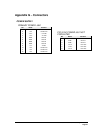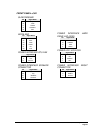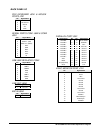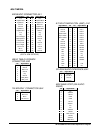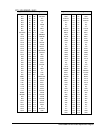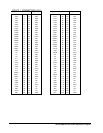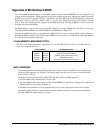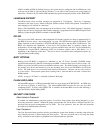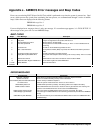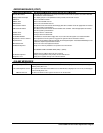
Advanced/RH Technical Product Specification •• Page 40
SETUP UTILITY
The ROM-based Setup utility allows the configuration to be modified without opening the system for
most basic changes. The Setup utility is accessible only during the Power-On Self Test (POST) by
pressing the <F1> key after the POST memory test has begun and before boot begins. A prompt may be
enabled that informs users to press the <F1> key to access Setup. A jumper setting (See table B-1 in
appendix B) on the motherboard can be set to prevent user access to Setup for security purposes.
PCI AUTO-CONFIGURATION
The PCI auto-configuration utility operates in conjunction with the system Setup utility to allow the
insertion and removal of PCI cards to the system without user intervention (Plug ‘N’ Play). When the
system is turned on after adding a PCI add-in card, the BIOS automatically configures interrupts, I/O
space and other parameters. PCI interrupts are distributed to available ISA interrupts that have been not
been assigned to an ISA card, or system resources. Those interrupts left set to “available” in the CMOS
setup will be considered free for PCI add-in card use. It is nondeterministic as to which PCI interrupt
will be assigned to which ISA IRQ.
The PCI Auto-Configuration function complies with version 2.10 of the PCI BIOS specification. System
configuration information is stored in ESCD format. The ESCD data may be cleared by setting the
CMOS clear jumper to the ON position.
PCI specification 2.1 for add-in card auto-configuration is also a part of the Plug ‘N’ Play BIOS. Peer-to-
peer hierarchical PCI Bridge 1.0 is supported, and by using an OEM supplied option ROM or TSR, a
PCI-to-PCMCIA bridge capability is possible as well.
ISA PLUG ‘N’ PLAY
The BIOS incorporates ISA Plug ‘N’ Play capabilities as delivered by Plug ‘N’ Play Release 1.0A (Plug
‘N’ Play BIOS V.. 1.0A, ESCD V.. 1.03). When used in conjunction with the ISA Configuration Utility
(ICU) for DOS or Windows 3.x, the system allows auto-configuration of Plug ‘N’ Play ISA cards, PCI
cards, and resource management for legacy ISA cards. Because the BIOS supports configuring devices
across PCI bridges, release 1.41 or greater of the ICU must be used with the Advanced/RH motherboard
to properly view and change system settings. System configuration information is stored in ESCD
format. The ESCD data may be cleared by setting the CMOS clear jumper to the ON position (See
Appendix B for jumper details).
The Advanced/RH BIOS also has a setup option to support the Windows 95 run time plug and play
utilities. When this option is selected, only devices required to boot the system are assigned resources by
the BIOS. Device Node information is available for all devices to ensure compatibility with Windows
95.
Copies of the IAL Plug ‘N’ Play specification may be obtained from the Intel BBS or from CompuServe
by typing Go PlugPlay.
ADVANCED POWER MANAGEMENT
The Advanced/RH BIOS has support for both 1.0 and 1.1 Advanced Power Management (APM). The
version of APM drivers loaded in the operating system by the user will determine what specification the
BIOS will adhere too. In either case the energy saving Stand By mode can be initiated by a keyboard hot
key sequence set by the user, a time-out period set by the user, or by a suspend/resume button tied to the
front panel sleep connector.
When in Stand-by mode, the Advanced/RH motherboard reduces power consumption by utilizing the
Pentium processor’s System Management Mode (SMM) capabilities and also spinning down hard drives
and turning off VESA DPMS compliant monitors. The user may select which DPMS mode (Stand By,
Suspend, or Off) to send to the monitor in setup. The ability to respond to external interrupts is fully
maintained while in Stand-by mode allowing the system to service requests such as in-coming FAX’s or
network messages while unattended. Any keyboard or mouse activity brings the system out of the energy
saving Stand By mode. When this occurs the monitor and IDE drives are turned back on immediately.



